What is the flex offense in basketball
The flex offense is a basketball offensive strategy that creates scoring opportunities near the basket or near the perimeter, typically by way of two types of basketball screens known as the flex screen and the down screen.
What is the basic setup of the flex offense
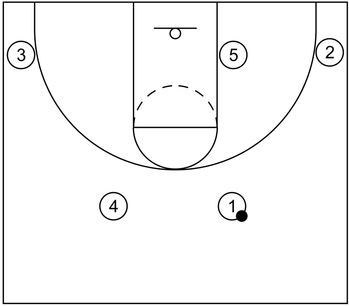
The basic setup for the flex offense is a 4 out 1 in alignment with two offensive players in the slot positions, two players in the corners, and one player near the low post area on the strong side of the court.
However, two offensive players could possibly fill the wings instead of the corner areas as an alternative variation of the flex offense.
What are advantages of the flex offense
One advantage of the flex offense is that it is typically easy to execute due to the simplicity of its rules involving the flex screen, down screen, and general continuity action.
Another advantage of the flex offense is that it is generally positionless and therefore, all five players could have an equal opportunity to score since each player could possibly cut to a new spot at some point during the offensive execution.
What are disadvantages of the flex offense
One particular disadvantage is that unlike a motion offense or other types of basketball offense strategies such as the Horns offense or the Princeton offense, which usually includes a variety of basketball cuts and basketball screens, the common flex offense typically only features the down screen, flex screen, and slot to slot action.
This makes it vulnerable to predictability and because of that, defenders could eventually anticipate the few offensive actions of the flex offense and then implement one or more defensive tactics to limit or prevent potential scoring options.
Nevertheless, it should also be noted that it is possible to mitigate the predictability to a degree by executing different offensive counters, variations, and/or entries as shown in the examples below.
Another general disadvantage to the flex offense is that it is not as useful against zone defense as opposed to man to man defense.
The reason that this could be a problem is because even if a zone defender gets caught on the flex screen or down screen, there would most likely be another zone defender nearby to quickly tag the offensive player who utilized those screens.
This, in turn, could increase the difficulty for the offensive team to score near the basket or gain high percentage open shots near the perimeter areas of the court.
What is an example of the basic action within the flex offense
Generally speaking, a player in possession of the ball near a slot initiates the flex offense, typically with a basic pass, such as a chest pass, to the opposite slot.
Following that, another player near the current weak side corner executes a flex cut towards the basket.
Afterwards, that same cutter then attempts to get open near the basket via a flex screen that is set by an offensive player near the low post block.
From there, the slot player who executed the initial pass would then cut towards the low post area to set a down screen for the player who set the flex screen. This is also known as screen the screener action.
After that, the player who set the flex screen uses the down screen and cuts toward the vacated slot area while the player who set the down screen fills the corner that was vacated by the player who executed the flex cut.
Also, as that occurs, the other slot player who received the ball could pass to the flex cutter near the basket if that is open.
Otherwise, if it is not open, the flex cutter fills the strong side low post block and following that, the player in the slot who currently has possession of the ball could initiate continuity action on the opposite side of the court.
Part 1
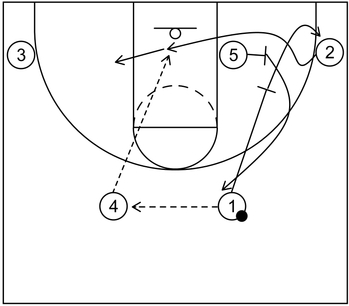
This is an example of the basic action within the flex offense, which also includes a continuity pattern.
To start, 4 receives the ball from 1 and afterwards, 2 cuts to the basket via the flex screen set by 5. Following that, 2 could receive the ball from 4 and score near the basket.
Additionally, as that occurs, 5 cuts to the right side slot via the down screen set by 1 who also cuts to the right side corner. Furthermore, if 2 is not open, then 2 could cut to the left side low post block.
Part 2
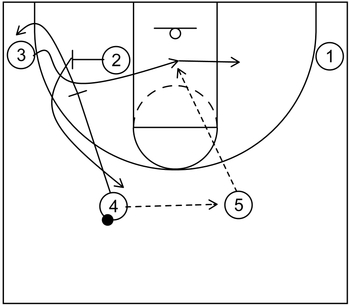
Next, 5 could receive the ball from 4 and this triggers the continuity action. Afterwards, 3 cuts to the basket via the flex screen set by 2, receives the ball from 5, and scores near the basket.
Also, if 3 is not open, then 3 cuts to the right side low post block. Furthermore, as that occurs, 2 cuts to left side slot via the down screen set by 4 who also cuts to the left side corner.
What is an example of a basic flex offense variation
Part 1
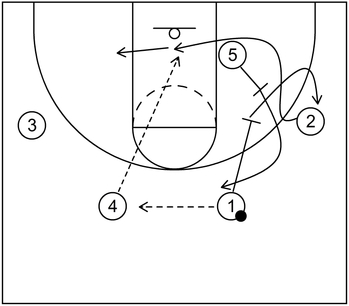
This is an example of a basic flex offense variation in which the players that are typically near the corners have lifted up towards the wings.
In this simple set, the offense pretty much runs similar to the standard version except that the flex screen, particularly for this case, is an angled back screen set closer to the wing area as opposed to the corner.
Moreover, it should be noted that the Swing offense utilizes this variation as a part of its fundamental structure.
To begin, 4 receives the ball from 1 and after that, 2 cuts to the basket via the angled screen set by 5. Following that, 2 could receive the ball from 4 and score near the rim.
Additionally, as that occurs, 5 cuts to the right side slot via the down screen set by 1 who also cuts to the right side wing area. Furthermore, if 2 is not open, then 2 could cut to the left side low post block.
Part 2
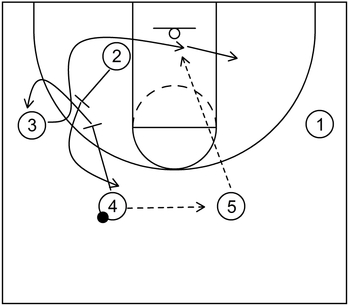
Next, 5 could receive the ball from 4 and this slot to slot pass initiates the continuity action. From there, 3 cuts to the basket via the angled screen set by 2, receives the ball from 5, and scores near the basket.
On the other hand, if 3 is not open, then 3 cuts to the right side low post block. In addition, as that happens, 2 cuts to left side slot via the down screen set by 4 who also cuts to the left side wing area.
What are examples of counter options for the flex offense
These are basic examples of counter options that could be implemented if the defense tries to take away the down screen, flex screen, or slot to slot action.
What’s more, each of the counter options use the variation where the screening action is at an angle towards the wing instead of the corner.
However, many of the concepts and examples could be used in the traditional flex as well, quite possibly with some minor adjustments.
UCLA Screen
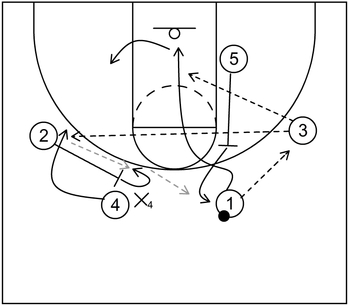
This is an example of a counter option that could get executed if the defense takes away the initial slot to slot action by denying in the passing lane. When that occurs, 3 receives the ball from 1 instead.
Next, 1 cuts to the basket via a UCLA screen set by 5. Also, as 1 cuts to the basket, 4 cuts to the left side wing via a flare screen set by 2.
From that point, if 1 is open, then 1 could receive the ball from 3 and score near the basket.
On the other hand, if 1 is not open to receive the ball, then 4 could receive the ball via a skip pass from 3. Afterwards, 4 could take the jump shot if open.
Conversely, if 4 is not open, then 5 fills the vacated right slot while 1 fills the left side low post block.
Following that, 2 could receive the ball from 4 and then 5 could receive the ball from 2, represented by gray dotted arrows.
From there, the offense could flow back into the flex action from the wing variation or the players near the wing could cut down to the corners to execute the standard flex if necessary.
Ball Screen

This is an example of another counter option if the defense denies the slot to slot action. This time, 1 dribbles to the left side slot via the on-ball screen set by 4.
As that occurs, 3 cuts to the basket via the angled screen set by 5. Following that, 3 receives the ball from 1 and scores near the basket.
If 3 is not open, then 3 would cut to the left side low post block, 5 would fill the vacated wing, and 4 would fill the right side slot.
Afterwards, 4 would receive the ball from 1 and the continuity would occur as before.
Shallow Cut
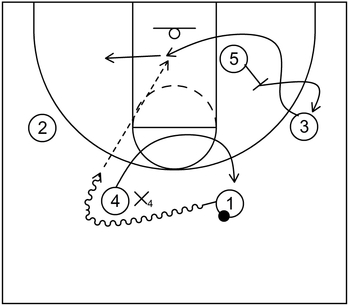
This is yet another example of a counter option that could be used if the defense takes away the slot to slot pass. When that occurs, 1 dribbles toward the left slot which triggers 4 to execute a shallow cut towards the right slot.
At the same time, 3 cuts to the basket via the angled screen set by 5 and could receive the ball from 1 to score near the basket.
Also, if 3 is not open, then 3 could continue to the left side low post block. Furthermore, 5 could cut to the right side wing after setting the screen. After that, 1 could start the continuity action.
Backdoor Cut
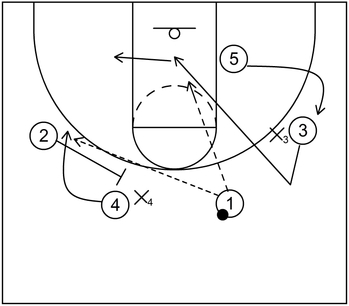
This is an example of a counter option that could be implemented if the defense denies the slot as well as the strong side wing. When that occurs, 3 executes a backdoor cut to the basket.
At the same time, 4 cuts to the left side wing via a flare screen set by 2, who also fills the left side slot after setting the screen.
Also, as 3 cuts to the basket, 5 cuts out to the vacated right side wing area. Next, 3 could receive the ball from 1 and score near the basket. If 3 is not open, then 3 could cut out to the left side low post block.
Afterwards, 4 could receive the ball as the alternative option and take the open jump shot. If 4 is not open to take the shot, then 2 could receive the ball from 4 and then the flex action could continue as before.
Furthermore, it is not shown on the diagram example, but if 4 did not receive the ball from 1 in the first place, then 2 could receive the slot to slot pass from 1.
After that, 3 could cut across the lane to the right side low post block and then the action could continue with 5 cutting to the basket via the screen from 3 instead.
Flip Screen – Part 1
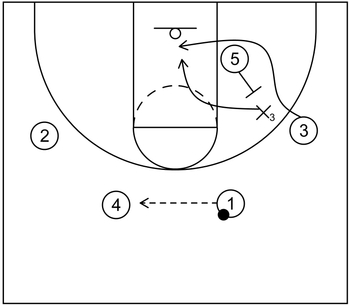
This is an example of a counter option that could get executed if the defense goes over or under the angled screen. When that happens, the player that initially set the angled screen can flip it into a down screen.
After that, the offensive player that utilized the first screen would then cut towards the slot area. So, for the diagram, 4 receives the ball from 1 and after that, 3 cuts to the basket via the angled screen set by 5.
However, X3 goes under the screen to meet 3 on the other side and take away the potential layup near the basket. This defensive action triggers the flip screen shown on the next diagram.
Flip Screen – Part 2
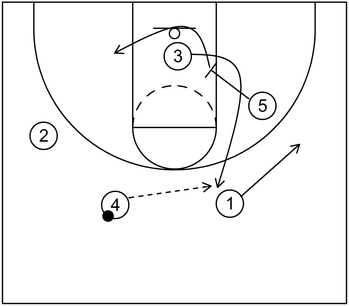
Next, 3 cuts to the right slot by way of the flipped down screen set by 5. At the same time, 1 cuts to the right side wing to fill the vacated space while 5 cuts to the empty left side low post block.
Following that, 3 could receive the ball from 4 and take the open jump shot. Also, it is not shown on the diagram, but if 3 does not take the shot, the offensive action could continue with 2 cutting to the basket via the angled screen set by 5 and so forth.
What are examples of entries into the flex offense
1-4 Low – Part 1
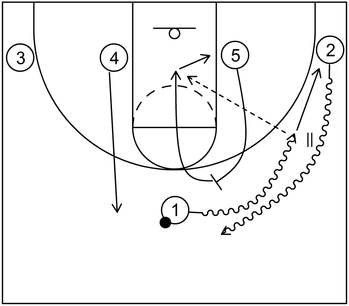
This is an example of a entry that begins with the 1-4 low formation but segues into the flex offense. To start, 1 dribbles toward the right side corner via an on-ball screen set by 5 while 4 fills the empty left slot.
Immediately following that, 5 rolls to the basket and could receive the ball from 1 if that is open. Otherwise, 1 executes dribble handoff action with 2 who then dribbles back towards the right slot.
Also, as that occurs, 5 self-replaces back to the right side low post block while 1 fills the right side corner.
1-4 Low – Part 2

Next, 4 receives the ball from 2 and afterwards, 1 cuts to the basket via the flex screen set by 5. Following that, 1 could receive the ball from 4 and score near the basket. If that is not open, then 1 would continue the cut to the left side low post block.
At the same time, 5 cuts to the right slot area via the down screen of 2 and then 2 cuts to the right side corner. From that point, although it is not shown on the diagram, 4 could pass the ball to the opposite slot, which could then start the continuity action.
1-4 High – Part 1

This is an example of a entry that starts with a 1-4 high alignment but changes into flex action afterwards. To begin, 2 receives the ball from 1 and then, 1 cuts to the basket via the UCLA screen set by 5.
Following that, 1 could receive the ball from 2 and score with a layup or dunk. If 1 is not open, then 1 could cut to the left side low post block.
Also, at the same time, 3 could fill the empty left slot area while 4 cuts to the left side corner.
1-4 High – Part 2
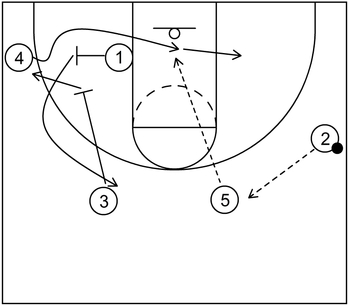
Next, 5 receives the ball from 2 and afterwards, 4 cuts to the basket via the flex screen set by 1. Following that, 4 could receive the ball from 5 and score at the basket if that is open.
Otherwise, 4 could cut to the right side low post block area while 1 cuts to the left slot area via the down screen set by 3.
Additionally, 3 fills the left side corner after setting the down screen and 2 fills the right side corner.
Horns – Part 1

This is an example of a entry that starts with a Horns alignment but changes into the flex set after that.
To begin, 1 dribbles towards the left side wing via the on-ball screen set by 5. Immediately afterwards, 5 could receive the ball from 1 and score with a layup or dunk.
If that is not open, then 1 executes a dribble handoff with 2 who then dribbles back towards the left slot area. Furthermore, 5 cuts out to the left side low post area, 4 fills the empty right side slot and 3 lifts up to the right side wing.
Horns – Part 2
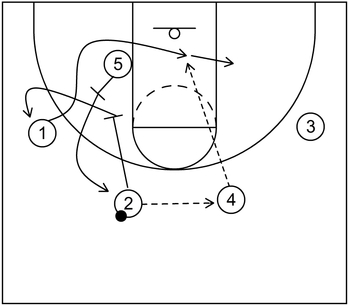
Next, 4 receives the ball from 2 and afterwards, 1 cuts to the basket via the angled screen set by 5. Following that, 1 could receive the ball from 4 and score near the basket. If that is not open, 1 could cut to the right side low post block.
Furthermore, 5 could cut to the left slot area via the down screen set by 2 and at the same time, 2 could fill the left side wing area.